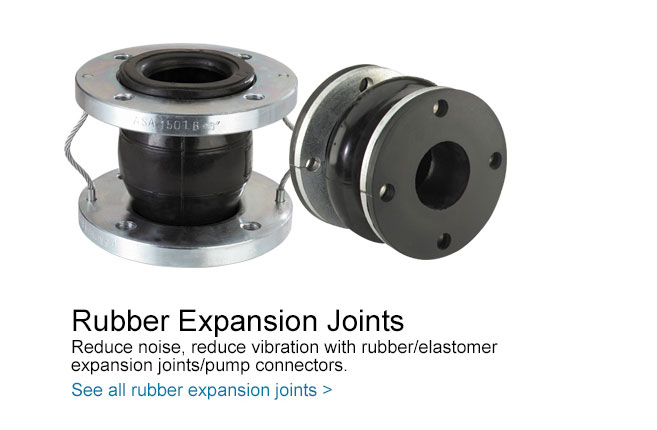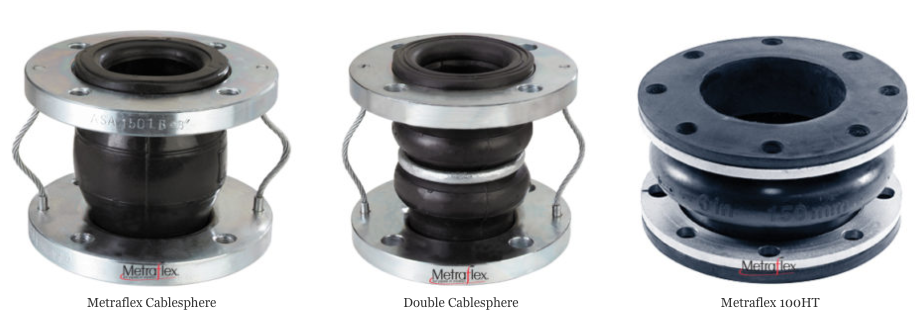In last week’s R. L. Deppmann Monday Morning Minutes, we examined the use of stainless steel hose and braid flexible pumps and equipment connectors in the HVAC industry. This week we look at rubber flexible connectors and compare. The first thing the reader will notice in the photo are the words “expansion joints” right alongside the words “pump connectors.”I identified in last week’s blog that hose and braid connectors will not move axially or in and out. Rubber connectors can elongate and compress which is the first major difference. Read on for more comparisons.
What are Rubber Flexible Connectors?
In the HVAC and plumbing world, we frequently refer to the term “rubber flex connectors”. In reality, the term “rubber” refers to a large number of elastomer type flexible connectors and expansion joints. A large majority of these products are made of EPDM, Neoprene, Butyl, Viton, and others. In general, they are compatible with the normal fluids and temperatures we use in HVAC applications. I recommend either EPDM or Butyl because they both have more resistance when used with glycols.
Another material concern involves outdoor applications. The UV rays can be detrimental to many elastomers. EPDM is acceptable, but the life of the flex connector will be less in an outdoor application. I tend to use stainless steel in those applications, although I may get some pushback by some manufacturers.
Movement in Rubber Pump Connectors
When it comes to movement, rubber connectors are much better than stainless steel. In the last Monday Morning Minutes, Hydronic Pump Piping and Trim: Should I use a Stainless Steel Flexible Connector?, it was clear that the hose and braid connectors needed to be lengthy in order to provide ½” or ¾” of lateral movement. In addition, they could not provide any axial movement. Rubber connectors are not as stiff and provide a great deal of movement. Let’s look at three examples from Metraflex.
The first photo is a Metraflex Cablesphere. A 6” Cablesphere offers ½” of lateral movement along with 5/8” compression. It is only 6” face to face, so it is compact.
The second photo is a Double Cablesphere and is called that for obvious reasons. This connector can have 1-1/2” of lateral movement and 2” of compression with only a 9” face to face height. This provides more movement than you should ever need in a pump connector.
The third photo is a Metraflex Model 100HT which can operate under a vacuum. This could be important on the suction side of a tower pump. Also, note that this connector does not have any cables or rods and those would have to be an included option.
Noise and Vibration Dampening Rubber Pump Connectors
Rubber connectors reduce noise transmission where stainless steel connectors do not. This can be an advantage when the mechanical equipment room is near a sensitive area. If noise is a concern, you should also look at pump and motor selections. Rubber connectors can also absorb cycling vibration much more than stainless steel. Again, you should not have vibration coming from a properly installed and operating centrifugal pump. The concern here would be the effect when something like a bearing starts to go bad. If the pump is near a sensitive area like a laser lab, vibration dampening could be an advantage.
What is the Downside of Rubber Pump Connectors?
So far it seems that rubber connectors have all the advantages. What are we missing? There are three areas where the rubber pump connector may have a downside.
- The first concern is installation. Rubber flexible connectors are not mechanically attached to the flanges. They rely on the flat or raised face mating flange to seat the rubber. Consult the manufacturer if you are using a grooved flange or PVC pipe. You should always specify the use of control rods or cables when using rubber pump connectors. Use them without the control units only if they are used as expansion joints with proper guides and anchors. There are also limitations when piped directly to a check valve.
- The second concern is the life of the connector. Rubber connectors have a usable lifespan. Depending on the application, the lifespan could be 30 years or it could be 5 years. The Fluid Sealing Association recommends inspecting the rubber pump connectors starting after 5 years. If the connector is getting hard or brittle, it is time to replace it. Temperature affects the lifespan. Rubber pump connectors on heating pumps will not last as long as chilled water applications. Personally, I have no issues using these on centrifugal pump hydronic applications. When properly installed and regularly inspected, these connectors will give you a long lifespan.
- The third concern is price. Last week I offered a couple of budget numbers on stainless steel hose and braid connectors. The Metra-Mini 6” Flex Connector low cost option had a budget price of $250, while the Model SLP with more movement was $500. The 6” Cablesphere has a budget price of $500 while the 100HT Model is close to $1,000. Obviously, in a world where low price matters, the short hose and braid connector is the low price leader and we see it used often.
What is the Recommendation?
If the pipe is properly aligned and pipe expansion has been included in the engineering, flexible connectors may not even be needed unless the pump is on a vibration base. That being said, ASHRAE 2016 HVAC Systems and Equipment chapter 44 shows them and the 2015 ASHRAE HVAC Applications Manual chapter 48 suggests that they are valuable in reducing flange loading. We sell flex connectors with almost every pump. If you ask me for a flexible connector with no specification, I’ll give you a Metra-Mini stainless steel hose and braid connector. Not much movement and inexpensive. If I was writing the specification for flex connectors I would use as a standard, I would specify both stainless steel hose and braid and the EPDM Rubber Cablesphere. My specification would require both types to have a minimum of 3/8” intermittent and ¾” permanent offset. I would limit outdoor applications to stainless steel. Any rubber connector provided must come with control cables or units. The only exception would be rubber connectors on the tower pump suction. Here, I would limit the use of rubber connectors to the 100 HT Model and specify the maximum vacuum. Here is a link to Metraflex where you can view the specifications to get you started.
One more comment. Both stainless steel and rubber connectors are available in reducing style. This is a great way to reduce the installation cost and should be allowed as a voluntary substitution in your specification. That way the contractor can decide which works best for the installation.
Next week, the subject of the R. L. Deppmann Monday Morning Minutes will be pump discharge check valves.



